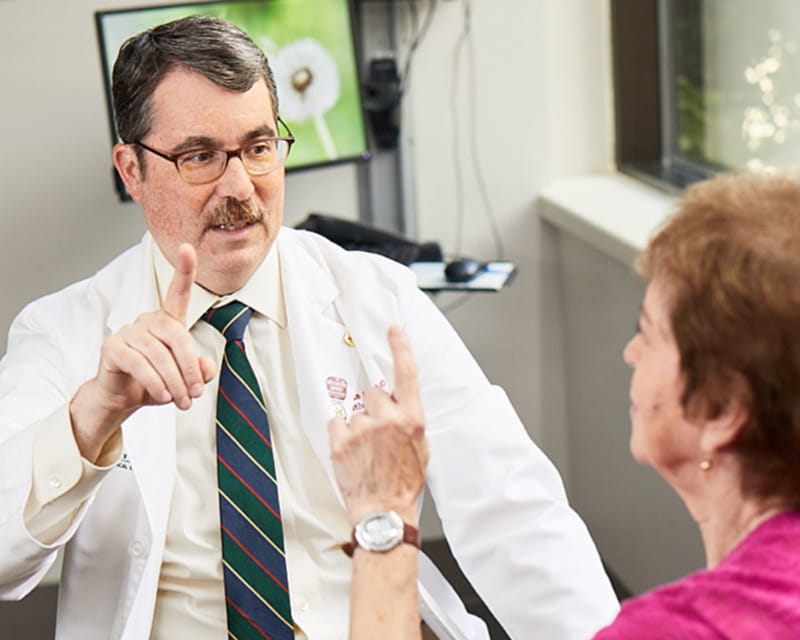
Ohio State researchers identify new biomarkers that differentiate Lewy body dementia from Alzheimer’s and Parkinson’s
 Department of Neurology embraces search for most effective models of care
Department of Neurology embraces search for most effective models of careTwenty years ago, doctors seldom discussed the impact of health care costs and a patient’s sociocultural status on treatments provided and outcomes achieved.
Yet an analysis of the varied dollar values and variety of care given to patients living with the dizziness and balance disorder called benign paroxysmal positional vertigo (BPPV) illustrates the need for expanded health services research in neurology, neurologist Kevin Kerber, MD, says.
Kerber and stroke specialist James Burke, MD, lead a new Health Services Research Division within the Department of Neurology at The Ohio State University Wexner Medical Center. The pair was recruited to build this new division, potentially the first such program within a neurology department in the United States.
Health services research uses scientific investigation to study how financing systems, health technologies, organizational structures and processes, personal behaviors and social factors affect “access to health care, the quality and costs of care and our health and well-being,” according to the Agency for Healthcare Research and Quality.
Researchers work to identify value in health care and find ways to promote that value, Kerber says. “We also identify waste and low-value health care services and find ways to limit those.”
The art of delivering health care is unbelievably complicated, Burke says. Physicians want to get the right care to the right people at the right time. But to do that, providers must understand myriad concerns, such as:
Health services research produces data, evidence and tools to make health care accessible, affordable, effective, equitable, patient-centered and safe. Study findings can allow providers and patients to make better decisions, help design health care benefits or inform policy. Health services research also tests, implements and disseminates tools and systems using trial-based designs.
The creation of this research-focused division means the Department of Neurology and Ohio State’s Neurological Institute are putting a stake in the ground when it comes to figuring out the most efficient way to provide high-value, appropriate neurologic care when people need it most.
“Our leaders are interested in a commitment to this kind of work,” Kerber says.
Health services researchers come from a variety of backgrounds, including behavioral science, engineering and management and policy. Many health services researchers are PhDs. Burke and Kerber actively see patients. Burke practices stroke neurology and provides hospital-based stroke management. Kerber treats patients with conditions related to balance and dizziness. Both teach general neurology to medical residents. Their clinical experiences round out their health services research motivations.
The Health Services Research Division at Ohio State’s Department of Neurology will use a four-pronged approach as Burke and Kerber begin to ramp up. Here’s how they describe it:
Health services research targets big problems and lots of different questions. Researchers can often use health insurance claims data that show who receives what treatments and where the treatments are provided to explore societal issues and their impact on health care delivery.
Burke and Kerber are building their neurology health services research division by adding support staff and developing infrastructure. They plan to hire project and database managers and build relationships with other neurology faculty interested in developing health services research studies.
“We’re putting the resources in place for fellows and practicing physicians who want to get training to become a health services researcher,” Kerber says.
The two neurologists see many avenues for growth in health services research at Ohio State. A new vestibular program led by the Department of Otolaryngology – Head and Neck Surgery provides opportunities for specialists from neurology and multiple specialties — emergency medicine; ear, nose and throat; physical therapy; primary care; and rehabilitation — to collaborate.
“By having these health services research conversations now, we’re making our system and our culture within it more aware of how we can provide better, more efficient care,” Burke says.
Kerber and his team are working on health services research studies to identify barriers to providing the right diagnosis and treatment.
As the health services research team grows, it will look to partner with health care systems, especially those in non-academic settings.
“Working with different systems is conducive to learning more in a less biased way,” Kerber says. “Our work with Kaiser is so important because they have a high level of organization, and we can get a sense of the real-world environment.”
Other future partners may include the Veterans Affairs Administration and Ohio State’s telemedicine and teleneurology programs.
Whenever possible, Burke, Kerber and their team plan to create resources other health systems can use to implement new learnings. They also plan to publish findings as appropriate.
“This is about culture and system change, and the biggest thing we can do is to take it one conversation and one trainee at a time,” Burke says. “Every idea, every discussion and every trainee who takes part — these are the pieces to help us get there.”

Ohio State researchers identify new biomarkers that differentiate Lewy body dementia from Alzheimer’s and Parkinson’s

Biomarker breakthroughs at Ohio State transform disease diagnosis, predictability and treatment

The Ohio State University Wexner Medical Center pushes boundaries for neurological care